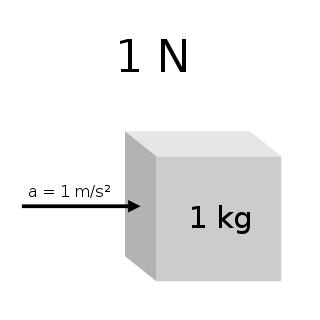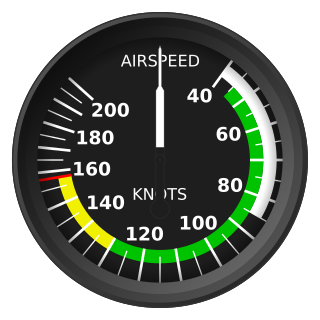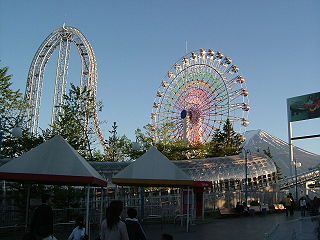Related Research Articles

In mechanics, acceleration is the rate of change of the velocity of an object with respect to time. Acceleration is one of several components of kinematics, the study of motion. Accelerations are vector quantities. The orientation of an object's acceleration is given by the orientation of the net force acting on that object. The magnitude of an object's acceleration, as described by Newton's Second Law, is the combined effect of two causes:

In everyday use and in kinematics, the speed of an object is the magnitude of the change of its position over time or the magnitude of the change of its position per unit of time; it is thus a scalar quantity. The average speed of an object in an interval of time is the distance travelled by the object divided by the duration of the interval; the instantaneous speed is the limit of the average speed as the duration of the time interval approaches zero. Speed is the magnitude of velocity, which indicates additionally the direction of motion.

The newton is the unit of force in the International System of Units (SI). It is defined as , the force which gives a mass of 1 kilogram an acceleration of 1 metre per second per second. It is named after Isaac Newton in recognition of his work on classical mechanics, specifically his second law of motion.

Physical geodesy is the study of the physical properties of Earth's gravity and its potential field, with a view to their application in geodesy.
The pound of force or pound-force is a unit of force used in some systems of measurement, including English Engineering units and the foot–pound–second system.
The cubic foot is an imperial and US customary (non-metric) unit of volume, used in the United States and the United Kingdom. It is defined as the volume of a cube with sides of one foot in length. Its volume is 28.3168 L.

The knot is a unit of speed equal to one nautical mile per hour, exactly 1.852 km/h. The ISO standard symbol for the knot is kn. The same symbol is preferred by the Institute of Electrical and Electronics Engineers (IEEE), while kt is also common, especially in aviation, where it is the form recommended by the International Civil Aviation Organization (ICAO). The knot is a non-SI unit. The knot is used in meteorology, and in maritime and air navigation. A vessel travelling at 1 knot along a meridian travels approximately one minute of geographic latitude in one hour.

The g-force or gravitational force equivalent is mass-specific force (force per unit mass), expressed in units of standard gravity (g, not to be confused with "g", the symbol for grams). It is used for sustained accelerations, that cause a perception of weight. For example, an object at rest on Earth's surface is subject to 1 g, equaling the conventional value of gravitational acceleration on Earth, about 9.8 m/s2. More transient acceleration, accompanied with significant jerk, is called shock.
The metre per second squared is the unit of acceleration in the International System of Units (SI). As a derived unit, it is composed from the SI base units of length, the metre, and time, the second. Its symbol is written in several forms as m/s2, m·s−2 or ms−2, , or less commonly, as (m/s)/s.
The poundal is a unit of force, introduced in 1877, that is part of the Absolute English system of units, which itself is a coherent subsystem of the foot–pound–second system.

Rotational frequency, also known as rotational speed or rate of rotation, is the frequency of rotation of an object around an axis. Its SI unit is the reciprocal seconds (s-1); other common units of measurement include the hertz (Hz), cycles per second (cps), and revolutions per minute (rpm).
In a compressible sound transmission medium - mainly air - air particles get an accelerated motion: the particle acceleration or sound acceleration with the symbol a in metre/second2. In acoustics or physics, acceleration is defined as the rate of change of velocity. It is thus a vector quantity with dimension length/time2. In SI units, this is m/s2.
The inch per second is a unit of speed or velocity. It expresses the distance in inches (in) traveled or displaced, divided by time in seconds (s, or sec). The equivalent SI unit is the metre per second.

Do-Dodonpa (ド・ドドンパ), formerly known as Dodonpa (ドドンパ), is a steel roller coaster located at Fuji-Q Highland in Fujiyoshida, Yamanashi, Japan. Manufactured by S&S – Sansei Technologies, the launched coaster uses compressed air to propel its trains. It opened on 21 December 2001 as the fastest roller coaster in the world with the fastest acceleration, reaching a top speed of 172 km/h (106.9 mph) in 1.8 seconds. The fastest speed record was previously held by Superman: The Escape at Six Flags Magic Mountain and Tower of Terror at Dreamworld, both of which accelerated to 160.9 km/h (100 mph) in 7 seconds. The ride was refurbished in 2017, removing the top hat element in favor of a vertical loop and increasing its speed and acceleration to 180 km/h (111.8 mph) in 1.56 seconds. Steel fabrication was provided by Intermountain Lift, Inc. In 2021, the ride was closed down indefinitely after multiple complaints of the ride breaking riders' bones were raised.
The foot per second is a unit of both speed (scalar) and velocity. It expresses the distance in feet (ft) traveled or displaced, divided by the time in seconds (s). The corresponding unit in the International System of Units (SI) is the meter per second.

In mechanics, the derivative of the position vs. time graph of an object is equal to the velocity of the object. In the International System of Units, the position of the moving object is measured in meters relative to the origin, while the time is measured in seconds. Placing position on the y-axis and time on the x-axis, the slope of the curve is given by:
A set of equations describing the trajectories of objects subject to a constant gravitational force under normal Earth-bound conditions. Assuming constant acceleration g due to Earth’s gravity, Newton's law of universal gravitation simplifies to F = mg, where F is the force exerted on a mass m by the Earth’s gravitational field of strength g. Assuming constant g is reasonable for objects falling to Earth over the relatively short vertical distances of our everyday experience, but is not valid for greater distances involved in calculating more distant effects, such as spacecraft trajectories.

A unit of measurement is a definite magnitude of a quantity, defined and adopted by convention or by law, that is used as a standard for measurement of the same kind of quantity. Any other quantity of that kind can be expressed as a multiple of the unit of measurement.

A coherent system of units is a system of units of measurement used to express physical quantities that are defined in such a way that the equations relating the numerical values expressed in the units of the system have exactly the same form, including numerical factors, as the corresponding equations directly relating the quantities. It is a system in which every quantity has a unique unit, or one that does not use conversion factors.
References
- ↑ "Feet per Second Squared". DiracDelta.co.uk – science and engineering encyclopedia. Archived from the original on 2012-06-14. Retrieved 2012-10-31.
- ↑ Lienhard, John H. "No. 1534: Acceleration". uh.edu.